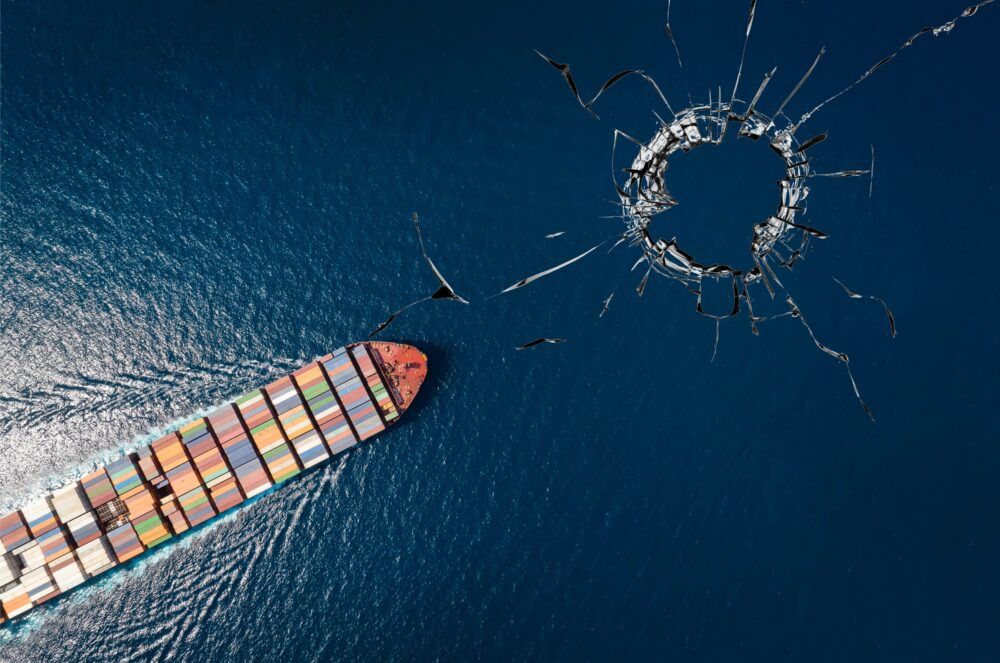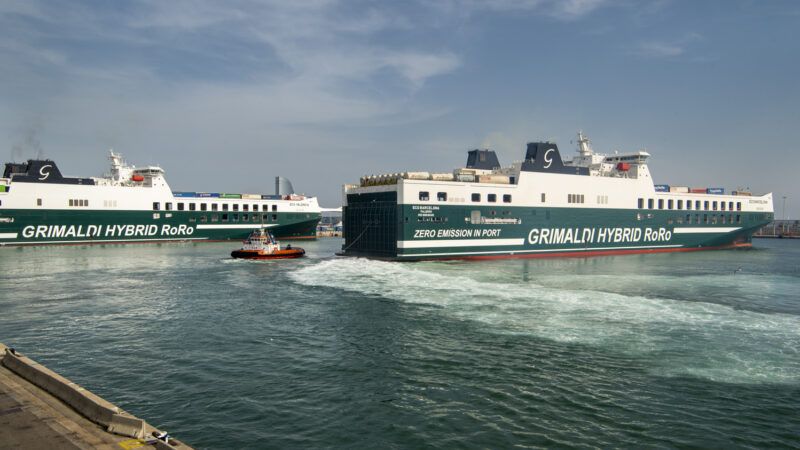
Disruptions shape shipping
Complex temporary scenarios that become permanent or new realities arising from disruptive events? The various situations experienced in the Suez and Panama canals and in the Red Sea continue to have an impact on shipping, trade and logistics and rethink future routes and scenarios.

Numbers speak for themselves
When figures are put on the table, they can be interpreted from several angles. According to UNCTAD's recent publication, Review of Maritime Transport 2024, in 2023 world seaborne trade grew by 2.4%.
However, their recovery remains fragile, as key crossing points such as the Suez (Red Sea) and Panama canals are increasingly vulnerable to geopolitical tensions, conflicts and climate change.
In 2023, maritime traffic through both channels was reduced by about half, forcing the planning of detours around the Cape of Good Hope, with an economic and environmental toll that is not sustainable over time.
For example, longer routes have increased fuel, wages, insurance, freight and emissions costs. For a 20,000 to 24,000 TEU vessel, the Far East-Europe route involves $400,000 in CO2 emissions to comply with the EU ETS.
“These disruptions, which were initially thought to be short term, have lengthened. It has been a year since the disruptions in the Red Sea began and we cannot rule out that this scenario will continue over time and that alternative routes will be consolidated. This entails another series of decisions and consequences, such as the acceleration of relocation or reshoring,” says Santiago Garcia-Milà, Deputy Director General for Innovation and Business Strategy at the Port of Barcelona.
In 2023, maritime traffic through the Suez and Panama canals was reduced by about half, forcing the planning of detours around the Cape of Good Hope, with an economic and environmental toll that is not sustainable over time.
Deviations that no longer are: the permanence of the temporary
When does a temporary situation become permanent? This is, according to the Port of Barcelona expert, the most current and relevant question. Discerning this question involves taking measures of one kind or another and, as far as the logistics chain and maritime transport are concerned, it also depends on the link in the chain to which one belongs.
However, Garcia-Milà recommends that this analysis should be carried out on a case-by-case basis, scenario by scenario, and always with the support of experts who can anticipate or draw forecasts linked to geopolitical contexts or those related to climate change.
“We can divide disruptions into different categories: economic, geostrategic, health and climate, etc.... Each one requires solutions in the short and medium term and anticipate, whenever possible, whether once the temporary scenario is over, we will return to where we were before or whether these disruptions will have changed certain aspects of logistics, transportation or international trade forever,” he reflects.
Climate change, for example, is already affecting the Panama Canal and could give the green light to the Arctic route. When will it become commercially attractive? For which markets? How will it affect the Suez Canal route, which could access northern Europe by another route?
“The answers to these questions have economic costs, involve strategic decisions at the level of transshipment for ports, and the design of new routes that can enhance or reduce the short sea with respect to the deep sea, for example. For logistics, it may involve changes in production, distribution or consumption. In short, these decisions have knock-on effects,” says Garcia-Milà.

Panama, a reversible drought?
Review of Maritime Transport 2024 defines maritime chokepoints as “those critical points along shipping routes that facilitate the passage of substantial volumes of commercial cargo, serve as vital arteries for global trade, and connect important regions around the world.”
Due to limited alternative routes, disruptions can lead to negative impacts on supply chains and systemic consequences affecting food security, energy supply and the global economy.
On a case-by-case basis, the Panama Canal is perhaps the most complex in the long term because the severe droughts it suffers as a result of climate change may be irreversible, although palliative measures are being taken.
To save water, the Panama Canal Authority restricted the number of ships passing through the canal. In May 2024, the number decreased by 19.2% compared to May 2023 and by 24.3% compared to the same month in 2022.
The United States is the main user of the Panama Canal, with 72.2% of the transit cargo volume in fiscal year 2023. The majority of exports from East Coast ports go mainly to Asia, and about 62.1 million tons of imports also come from the same continent.
Since January 2024, the Panama Canal situation has improved due to the onset of the rainy season, along with water saving measures, which has allowed for a gradual increase in daily transits.
Although 34 ships per day were allowed to pass through in April, this figure is somewhat lower than the average of 38 recorded before climate change accentuated this problem.

Suez Canal and Red Sea, collateral victims of instability
Since mid-November 2023, disruptions along the Red Sea shipping route have prompted the decision by major shipping industry players to suspend transits through the Suez Canal.
The number of monthly traffics in all vessel segments has decreased since the onset of the instability, significantly on the Asia-Europe and Asia-Atlantic trade routes, which have diverted their routes and started to sail around the Cape of Good Hope.
These changes expose Europe to increased costs, given its dependence on imports from Asia, as well as disruptions in the foreign trade of many developing countries that rely heavily on the Suez Canal. This is the case for East African countries, whose disruptions have led to shortages of perishable goods due to increased cargo delivery times.
This circumstance has also increased the average distance traveled which, in the case of bulk carriers and tankers, has had an impact on freight rates.
According to the UNCTAD report, the new tanker route from the port of Ras Tanura (Saudi Arabia) to Rotterdam via the Cape of Good Hope has resulted in a 42% increase in voyage time.
“The degree of involvement of these situations and their effects is greater or lesser depending on the region of the world we are in. For example, the closure of the Suez Canal has affected ports in the western Mediterranean, which have had to increase the number of transshipments. And shipping lines, for their part, have placed more vessels to supply these longer routes. On the other hand, the degree of confluence of global analyses is quite similar around the world, as well as the priorities around issues such as decarbonization, digitalization, innovation, efficiency, etc.,” notes García-Milà.
The number of monthly traffics in all vessel segments has decreased since the onset of the instability, significantly on the Asia-Europe and Asia-Atlantic trade routes, which have diverted their routes and started to sail around the Cape of Good Hope.
Implications beyond maritime transport
When the container ship Ever Given blocked the Suez Canal for six days, it caused about $10 billion in goods a day to be stranded. These disruptions can lead to changes in the configuration of trade supplies.
For example, tensions in the Black Sea have led Egypt to source grain from Brazil or the United States instead of Ukraine, and oil shipments from the Russian Federation went to China and India instead of Europe.
Of the eight major bottlenecks, the Bosphorus and Dardanelles Straits crossings continued to experience complications in 2023 and 2024. In September 2023, Turkey implemented regulations to improve environmental standards, safety measures and protocols, and traffic management. However, delays and traffic jams have occurred during the period of adapting to these regulations.
“More or less protectionist decisions such as, for example, those that Donald Trump or Europe may take with tariffs on Chinese electric vehicles also influence the ports. If instead of importing cars they start to be manufactured here, part of the import of vehicles would be replaced by that of components,” explains Garcia-Milà.
Therefore, these trends even involve decisions in the port infrastructures themselves. For the Port of Barcelona's Deputy Director General for Innovation and Business Strategy, the message remains the need for all players in the sector to “analyze the degree of permanence of this whole set of disruptions in a cross-cutting manner and the consequences they entail individually and for the sector as a whole,” he adds.

Solutions do exist...
...But they are complex, like the current scenarios.
UNCTAD proposes some recipes. Many of them are strategic and short-term, based on resilience, and with ports as protagonists:
- Expand and combine transportation modes to reduce reliance on bottlenecks, avoid disruptions, and ensure a steady supply of cargo.
- Improve infrastructure facilities, including port capacity, storage facilities, pipelines, and bunkering facilities to increase reserves and minimize shortages or delays.
- Reduce the risk of relying on a single source of inputs by diversifying supply and manufacturing locations.
- Diversify shipping routes to avoid over-reliance on major hub ports and develop contingency plans that include alternative routes and ports.
- Improve cooperation between shippers, logistics providers and ports to optimize supply chain efficiency, reduce transit times and transportation costs.
- Strengthen commercial pacts and alliances and collaboration to manage risks and disruptions in supply chains.
- Utilize technology, data, demand forecasting and early warning systems.
Santiago Garcia-Milà added that adopting mechanisms that allow flexible reactions to increase adaptability to these scenarios may be another key. The ability to do so in such a complex chain depends on many variables and on the tools available to each of the agents.
“If we can ensure that the entire port operation is hyper-efficient, we will facilitate and streamline the operation of the entire logistics chain. Digitalization, AI or data sharing can help us increase predictability and contribute to the effects of these disruptions being lessened,” he concludes.






